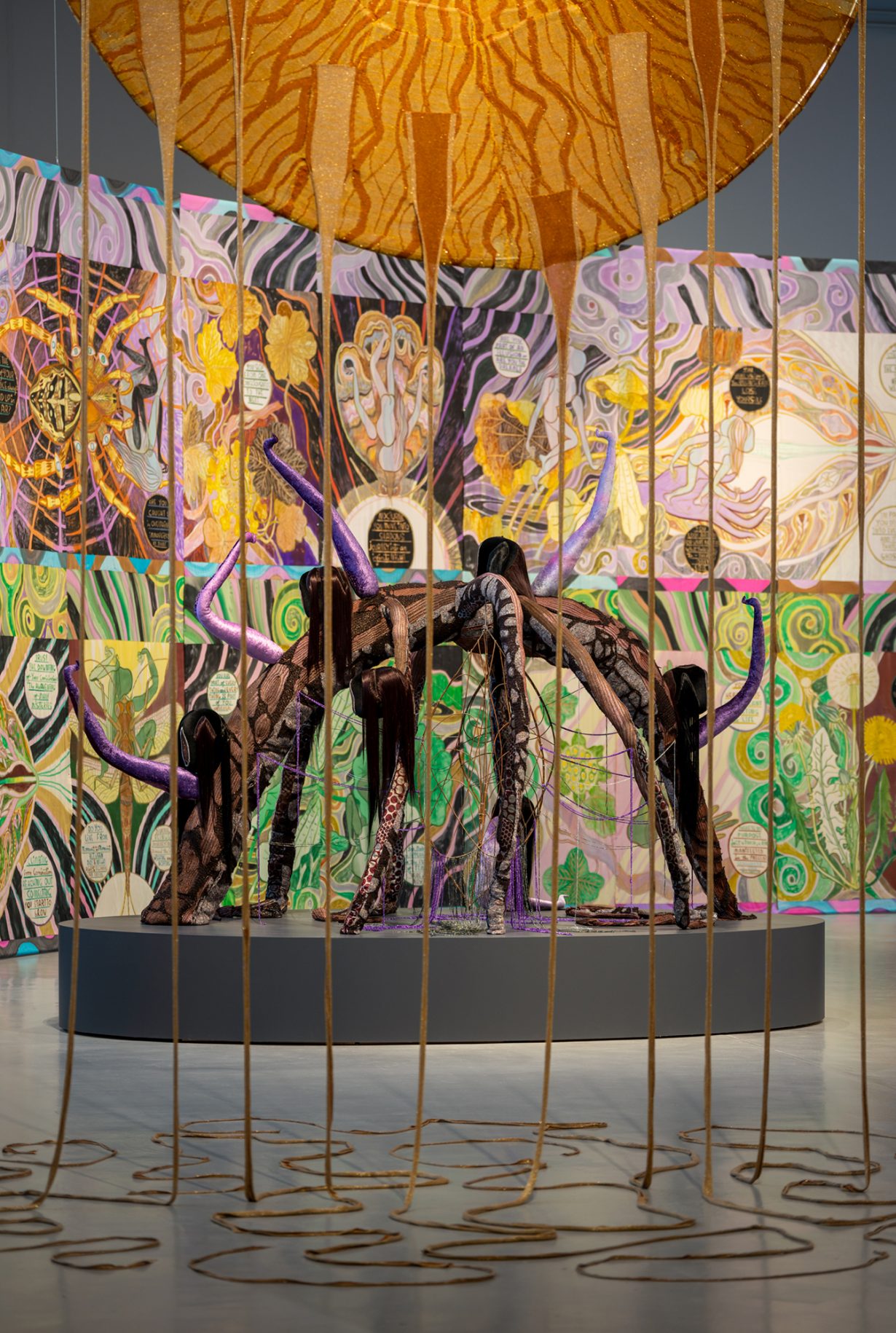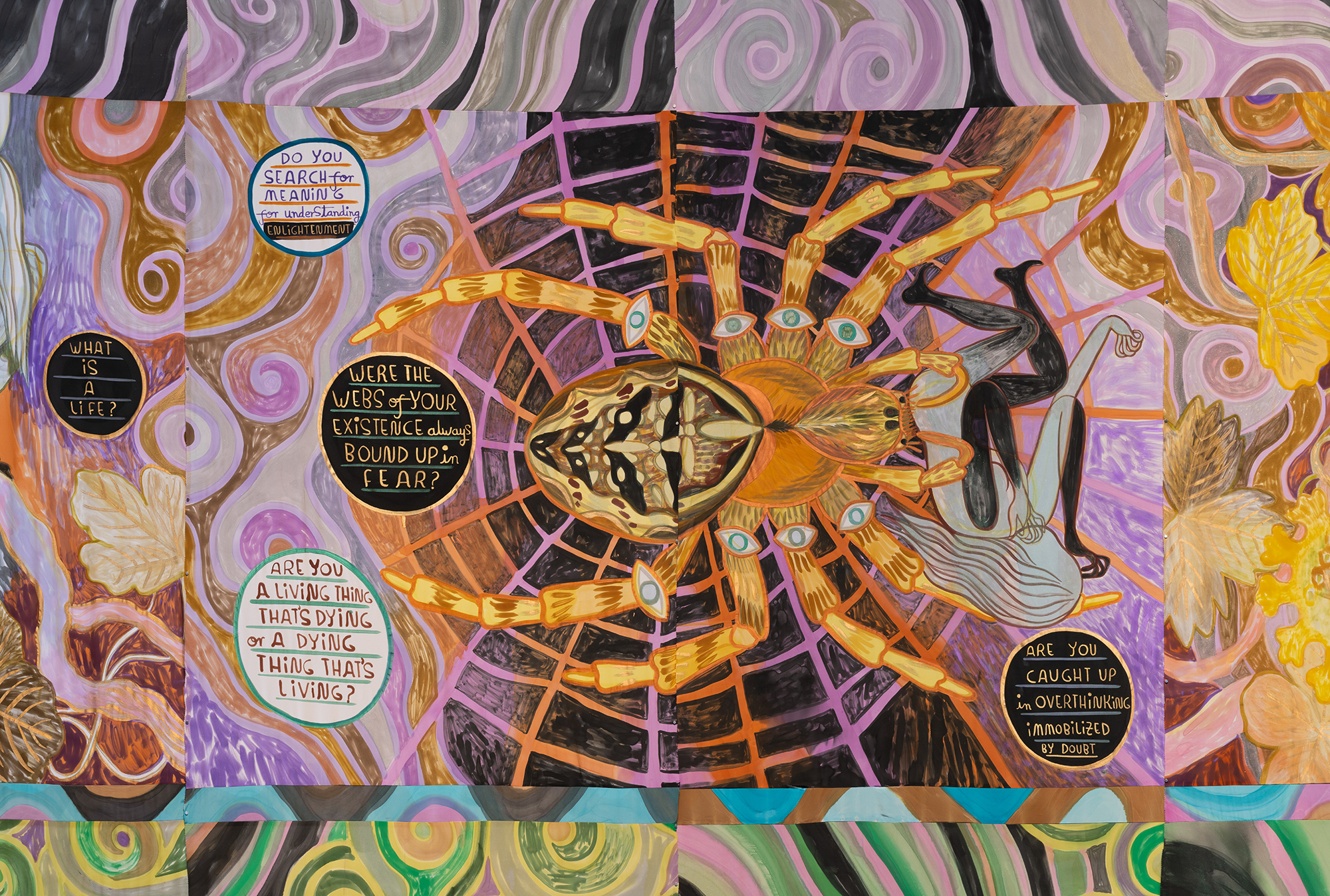Talbot’s latest exhibition of silk paintings delves into the looming catastrophic outcomes of the Anthropocene and suggests an alternative
Historians have the uncanny ability to recognise patterns in current events that many of the rest of us believe, insist even, are unique to us. Instead, they’re almost comically cyclical. What happens, though, when our era of extremes, dominated by an elite of unimaginable wealth, plunders our planet to the point of no return, the cycle of human history broken? More importantly, what will it take for us to act, to imagine a different system? In Are You a Living Thing… Emma Talbot delves into the looming catastrophic outcomes of the Anthropocene, and counterbalances them with a worldview rooted in interspecies connection, sustainability and human resilience.
Stepping into the exhibition feels a bit like stumbling into some mythological land: teeming flora and fauna on the one hand, dystopian devastation on the other. Comprising recent colourful drawings, installations, paintings and animations, Are You a Living Thing is immediately recognisably Talbot, who has honed a distinctive visual language that alludes to ancient mythologies, with patterned abstractions and repetitions, yoni symbols and swirls, and lyrical figuration. We are greeted by the suspended, machine-knitted luminary Close Friends: The Sun (2023). Glistening in metallic yellows and tangerines, its rays unravel downwards, coiling onto the ground. The Sun is part of a series that includes three other textile works, all varying homages to the natural cycle of growth, time and interconnection: the suspended Close Friends: The Moon, shimmering silver and full, and – freestanding on plinths – Generative Plants, a totem of bodies in shades of turquoise and greens that rise upwards, and Old Tree, Spells and Incantations (all 2023), a spidery tangle of purples, golds, bronzes and blacks, its title suggesting an ancient connection with nature.

Two suspended, 11-metre-wide silk paintings create a vivid, expansive and immersive environment, doubling as curved backdrops to her sculptural pieces. Talbot turned to the flowing, irregular texture of silk very early in her practice, when she felt constrained by the traditional stretched, rigid canvas. Painting on fabric also means the paint soaks through the silk, so it encourages walking around, observation from the front and back of the work. Here, employing Talbot’s text-bubble-driven storytelling, her recurring faceless female heroine traverses two distinct future pathways for humanity. In Everything Is Energy (2024), we are presented with a wild hellscape of postapocalyptic proportions, all toxic water and deadly radiation that has decimated life. A text bubble asks, ‘Will you become landfill / buried waste, discarded / surplus to requirements / the beautiful dream / of life, dead in / your eyes.’ Out of this hell, a plant unfurls, germinating, pointing to the resilience of plants even after we have wrought our own extinction. Are You a Living Thing That Is Dying or a Dying Thing That Is Living? offers a hopeful counterpoint: a sustainable life, swarming with vegetation and insects, and centred on creativity, care and interconnectedness with nature. ‘Is this how we face our own expiry,’ another text asks, ‘in resignation or revolution.’
In her celebrated 2014 speech at the National Book Awards, Ursula K. Le Guin reminded us how resistance and change often begin in art. Similarly, Talbot’s art bears witness to the seemingly inescapable times we live in, but also shows that an alternative common future is within our grasp. What path will we choose? The sensible answer appears laughably simple, yet here we are, careening towards our own expiration, confusing social and political ideologies with absolute truths.
Are You a Living Thing That Is Dying or a Dying Thing That Is Living? at Copenhagen Contemporary, through 31 August
From the May 2025 issue of ArtReview – get your copy.
